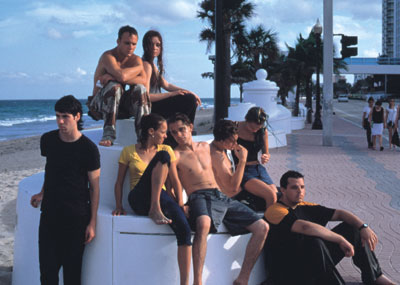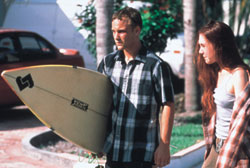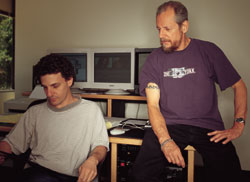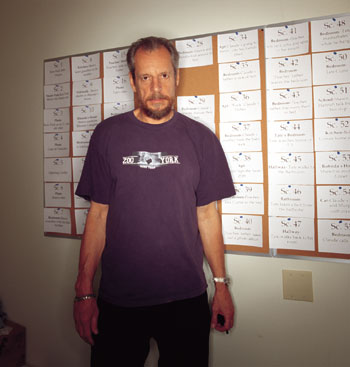AGGRESSIVE BEHAVIOR
In nine months, artist and filmmaker Larry Clark has shot three features – Bully, Ken Park and Teenage Caveman. Chuck Stephens talks with Clark about his current work obsession.
Larry Clark Photographed by Mario De Lopez
This is no beatnik movie," exclaims Larry Clark, looking healthy, happy and busy as hell as he waits for editor Andrew Hafitz to cue up a scene from Ken Park, one of three new films that the infamous and influential photographer and filmmaker is rushing to complete before summer’s end. "I never even thought about shooting it on video. It’s film, I’m a photographer, and this is going to look like a $20-million picture – like something Conrad Hall might have shot."
Sitting next to Clark, in the small editing suite somewhere along a busy boulevard in North Hollywood, is Edward Lachman, the noted cinematographer of The Limey, Erin Brockovich and The Virgin Suicides who is also Clark’s Ken Park co-director. When Hall’s name gets dropped, Lachman – who called in favors from Kodak and the lab CFI and (with Clark) put his salary directly into buying film stock for the film – smiles obligingly, if a bit skeptically.
"The main thing," Lachman explains, "is that video’s just not up to the level of the visual language of film, and there are too many compromises." "Yeah, like we couldn’t have any deep blacks," laughs the 57-year-old Clark, his warm and throaty voice seizing the absurdity of turning away from the medium that’s served him well ever since his days as an assistant baby photographer, a million years ago.
The past isn’t through with him yet: Ken Park, shot in Visalia, Calif., is, Clark says, based on the director’s perhaps misspent but certainly well-documented youth as one of the many teenage terrors of Tulsa, Okla., and was written by writer/director Harmony Korine shortly after the time Korine authored Kids for Clark. "This one’s about the parents," Clark used to tell his admirers about Ken Park when they would wonder what the director could possibly graduate to after the controversial and epochal Kids. Today he’s more likely to explain that Ken Park is the closest he’s come to turning his second book – the sexed-up, drugged-out youth study Teenage Lust – into a film.
At last Hafitz – who also cut this summer’s Lions Gate release Bully, Clark’s lyrical, true-crime study of sex, drugs and homicide among directionless teens in the beachside mallville of Hollywood, Fla. – finds the cue Clark’s been waiting for somewhere among the 180,000 feet of film they exposed for Ken Park. In the scene, a young girl of about six sits in a suburban living room, distractedly playing with her toys in front of a big-screen television that’s beaming out images of bikini-clad crotches. Upstairs, a teenager named Shawn (James Bullard) is in the bedroom of his girlfriend’s mother, an ample blonde who stops folding laundry and gives Shawn her full attention when he bluntly asks, "Can I eat you out?"
A few hours later Clark will be in another editing room halfway across town, working on a project for HBO called Teenage Caveman, one of five made-for-cable remakes of producer Samuel Z. Arkoff’s cheapo monster flicks from the 1950s. Clark’s version takes place in the ruins of a postapocalyptic Seattle, and although it’s filled with gut-churning makeup effects by veteran monster-maker Stan Winston, it’s as much of a return to the booze, bongs and adolescent bravado of Kids as any of Clark’s fans could want, and a testament to the tenacity of a filmmaker who refuses to compromise his vision of the terrifying beauty of teenagers or his determination to get those visions on screen. Welcome back, Larry Clark.
 |
| The cast of Bully. |
FILMMAKER: You’ve had the idea for Ken Park for a long time, at least since the time that Kids was released. Where did it come from, and how did it develop?
LARRY CLARK: I first met Ed Lachman in Austria at a photo exhibition in the late ’80s, way before Kids. He was, like, the first guy I met in the film world. He knew the ropes, and I was just a fucking photographer; I didn’t know anything about making films. I’d done a series of video collages in the ’80s, and I had all these characters and stories in my diaries about what had happened to them. But when I tried to turn [these stories] into a script, it was like five different movies about five different people. So we tried to get a screenwriter who could turn it into a screenplay, but we never really found the right person. This went on for a couple of years, and in the meantime I got the idea for Kids and I met this kid, Harmony Korine, and well, that story’s pretty well known. I came up with the story, and he wrote the dialogue and the screenplay. While I was making Kids, Ed found a writer in L.A. to write Ken Park, so I flew out there and gave the guy all the material, the diaries, the treatment, copies of my collages and my videos, all the raw material, and flew back to New York. On the plane, I started thinking that maybe Harmony should write it instead, so when I got home I called Ed and said, ‘You have to get all the material back from the guy,’ who was already all stoked. But when I gave the material to Harmony, the characters and the stories, he looked at it and said, ‘I don’t know these people at all.’ Kids he knew because he was hanging out with those kids. But he said he’d try, and what he did was brilliant. He did one draft, and I didn’t have him do another; it was rough, but I knew I could make the film from it.
FILMMAKER: Did those diaries and videos become your third book, The Perfect Childhood?
CLARK: Exactly. There’s stuff in there like autoerotic asphyxiation, and stuff like the kid who kills his parents, which Harmony changed to a kid killing his grandparents, since he lived with his grandmother, which was kind of cool. A lot of it comes from a series of video installations I’d done where I’d taken a lot of these kids’ stories off of, like, Donahue and edited them down into little seven-, eight-minute pieces. There was also stuff in there that I showed Gus Van Sant when he was making To Die For. Ken Park is filled with things I’ve been interested in for years. You’ve got the kid who’s sleeping with his girlfriend’s mother, the kid who’s abused by his father while his mother just plays it off like there’s nothing going on, the teenage girl whose parents are religious fanatics and she acts out by fucking all the boys in the neighborhood. That comes from a girl I knew when I grew up. Her father was afraid she was going to go out and sin; he was a real Pentecostal nut, and she wasn’t even doing nothing, but he would lock her in the closet and beat her with the Bible.
FILMMAKER: Did you change the script after Harmony wrote his draft?
CLARK: Well, yeah, because, you know, he was a middle-class Jewish kid writing about people he didn’t really know about. So when we made the film, there was a lot of stuff that didn’t make sense that I changed. We just kind of made up new stuff as we went along. Every morning we’d read what we were going to shoot, and if it didn’t make sense we’d change it. There was a lot of improv, and we changed the end, which I never liked.
FILMMAKER: Would you say that the way you’re making Ken Park is the closest you’ve come in your films to your work process with photo and collage?
CLARK: I guess so, but all my films have been that way. Most of Another Day in Paradise was improvised. I took a story and put myself into it and changed almost the whole script as we went along. Kids, too.
FILMMAKER: There’s been a lot of talk lately about the incursion of actual penetration shots in sex scenes in some European films. If you could get away with that here, would you?
CLARK: I’m doing it anyway. I don’t wait for permission. In Ken Park you’re going to see some stuff you’ve never seen before in a film that I know of.
FILMMAKER: Such as?
CLARK: Wait for the movie. It’s all based on real things that have happened to real people. I decided that I wasn’t going to turn the camera away, or shut the door, or shoot from the waist up. Ken Park is going to be a lot like the work in Teenage Lust.
FILMMAKER: Bully seems to have come together much more quickly than Ken Park did.
CLARK: Yeah. I started Bully a week before my kids started school last fall, and they get out of school next week, which is when we lock the film.
FILMMAKER: How old are your kids?
CLARK: My daughter’s 15, my son’s 17, almost 18. He was 12 when I made Kids.
FILMMAKER: Do they see your films or your other work?
CLARK: They do now. My daughter was too young to see Kids when it came out; my son was 12, and he saw it. He said "Dad, I’ve never seen anything like that before!" I said "No, you probably haven’t."
FILMMAKER: Bully hasn’t had any long lead publicity, and here you are finishing it just a month before it’s being released. Do you think Lions Gate is afraid of the film?
 |
| Brad Renfro and Rachel Miner in Bully. |
FILMMAKER: Bully looks fantastic. Your d.p., Steve Gainer, really captures the visual style of your still photography. How did you go about working with him?
CLARK: He’s amazing. He’s very fast. He’s like me; nothing can stop him. We shot Bully in 23 days, so quick. No rehearsal, we just did it. We had no rehearsal on Teenage Caveman, either – he shot that, too – we just jumped right in and shot it in 18 days. I had more time for Ken Park, 36 days or so. I’m getting good at making movies fast. I almost feel I know what I’m doing.
FILMMAKER: Was Gainer already familiar with your work?
CLARK: Yeah, somewhat. I just basically told him how I wanted to shoot it. Like, for example, I like longer lenses. Like, if you frame up the perfect image, the perfect composition on a 35mm, I go to a 50. And if you get everything perfect with the lights and the composition and everything with the 50, I go to an 85. It’s like, I can give you one photography lesson, and that’s all I know: you find the perfect composition, you get everything exactly the way you want to be, all framed up perfectly, and then you take a step forward. Then you’re fucking it up a little bit, you’re getting a little closer – it’s more random, more like real life. That’s what I do when I’m making films, too. Now I’ve given you all my secrets; you know everything.
FILMMAKER: What you just said about taking a step forward brings to mind a shot in Bully in which Lisa is on the phone and there’s all this stuff in the room between her and the camera.
CLARK: Yep. I love foreground. It gives the image a three-dimensional quality, and visually it gets very exciting. Kids is foreground all the time. I was on a plane going to L.A. one time, and Dennis Hopper was on there, too, and he got up and came over to me and said, "Hey, I really liked your movie. I especially liked all that, that," – and he’s wiggling fingers in front of his face – "that …" And I said, "That’s what’s called foreground, Dennis."
FILMMAKER: There are two writers credited on Bully. Did you work on the script as well?
CLARK: I had the script, but the book was what was happening. And when I’d ask the writer to put a scene from the book back in, he’d still edit it down and make it stupid. So what I’d do every morning is go back to the book and have my assistant type out the dialogue straight from the book, so the dialogue’s, like, verbatim from the book in almost every instance. But there’s so much stuff in the book, that it was mainly a matter of what to leave out. The relationship between Bobby and Marty was very complex and had so many different levels, so I tried pick and choose and get as much of a sense of all it as I could. When I got the screenplay, all the gay stuff was left out, and they’d turned Marty into this little angel and Bobby into a monster, and it wasn’t that way at all. Marty was actually as bad as Bobby in a lot of ways. When Marty was around other people, he was kind of okay, but when he got with Bobby, it was a chance for his dark side to come out.
FILMMAKER: Did Bobby deserve to die?
CLARK: I don’t think so – not like that, anyway. It’s interesting that some people will relate to Bobby and think that he’s got more going for him than the rest of the kids in the movie, and think that they deserve to die more than him. But the thing is, there really are a number of different movies that could have been made from the book.
FILMMAKER: There are a lot of things in the film that seem like nobody could have put them there but you. Like the scene that, for me, is the most beautiful one in the movie: near the end, Marty gives his younger brother his earring and then hugs him. The kid doesn’t say anything, but the look on his face, of confusion and adoration, is incredibly powerful.
CLARK: I made that scene up on the spot that day. The kid who was playing Marty’s brother just had one scene in the script, and he didn’t have any dialogue. But when I saw the kid, I just started making up scenes for him.
FILMMAKER: Who is Marty talking to on the phone in the first shot of the movie when he says, "I want you to suck my dick"?
CLARK: He’s talking to some gay guy, because he and Marty did phone sex for money. In the first scene, you have no idea that he’s doing phone sex, but later when they’re in the gay club you see that Bobby’s kind of his pimp, and he tells the gay guy that Marty gives great phone. The guy says, "Can I call him?" and Bobby says "No, he’ll call you." There was a lot of material about that in the book, and I was just going through and trying to figure out how I could get as much of it into the movie as possible. And most of it happened quickly, in the heat of battle, which is when I operate best.
FILMMAKER: Was the scene between Bobby and his father – the bathroom scene in which his father walks in on him while he’s naked – in the book?
CLARK: Um, I kinda threw that in …
FILMMAKER: That’s what I mean about some scenes feeling like they’re yours.
 |
| Nick Stahl and Bijou Phillips in Bully. |
CLARK: In the book, you don’t really get to know too much about Bobby. I didn’t really do anything to change that scene except to have Bobby naked, so it’s ambiguous what’s going on there. The challenge to doing a scene like that is talking the actor into it: "By the way, you’re gonna be naked in this scene." "What?!"
FILMMAKER: Bijou Phillips didn’t seem to have any problem with it.
CLARK: Uh, I don’t think I need to say anything about Bijou. Let’s just say Bijou was perfect for the role.
FILMMAKER: She didn’t seem to shy away from you putting the camera right up in her crotch all the time.
CLARK: I’m, I’m, I’m not going anywhere with that one.
FILMMAKER: How did you get involved with Teenage Caveman and the Creature Feature series?
CLARK: What happened is, there was this big, well-known producer in the 1950s and ’60s, Samuel Z. Arkoff. He did a ton of movies like Teenage Caveman, She-Creature, How to Make a Monster and some of the beach party movies. His son, Lou Arkoff, now owns the rights to all those early films, so he made a deal with HBO. Lou’s partner is Stan Winston, this guy who makes movie monsters and does makeup effects. So they asked me to do one, and the only thing I had to do was pick one of Sam’s old titles. She-Creature was already gone, so I took Teenage Caveman, which I actually saw in 1958, so it’s kind of an homage to my youth, when I saw these movies in the Tulsa Theater in Oklahoma. Those films represented the fears of the ’50s, right? Communism, the commies next door, the bomb, and out of the radiation would come a monster. So the idea was to bring the films up to date to reflect the fears of today.
FILMMAKER: Which are?
CLARK: What we’re doing to the planet, ecological fears. And disease, AIDS and HIV, and sex and disease. But it takes those things to the same kind of extreme that the ’50s monster movies did. One of the reasons I decided to do it was that I thought it would be fun to work with Stan, who made these incredible puppets, and people morphing into these puppets that explode. One kid gets his head pulled off – it’s really cool. I liked the idea of making a film in 18 days. No matter who you are or what you’ve done, anybody who can make a film in 18 days has got to be crazy. I took that as a challenge. And it was exactly like the kind of film I might make anyway, except with a creature.
FILMMAKER: Will your fans be able to look at it and immediately recognize it as a Larry Clark movie?
CLARK: Well, it’s not like any of the other Creature Feature movies, that’s for sure.
FILMMAKER: Nudity?
CLARK: A lot of nudity.
FILMMAKER: Were the producers worried?
 |
| Editor Andy Hafitz and Larry Clark. Photo: Mario De Lopez |
FILMMAKER: How does it feel to be working in television? You wouldn’t exactly seem to be the most likely candidate for the job.
CLARK: The first thing I said to my editor is that whatever we do, it needs to be anti-TV. If the scene seems to go on too long, that’s good. If it meanders, that’s good. Whatever TV does to clean things up, I don’t want to do that. I approached it like it doesn’t have to be a linear story at all. Like, there’s this drunken orgy scene in the middle, and it feels like what that kind of scene should feel like: long and slow and fucked up.
FILMMAKER: Just the opposite of the shooting schedule.
CLARK: Yeah. We started shooting 10 days after I finished writing, and I cast it during those 10 days. It was right before the actors strike was supposed to happen, so everybody was already working and there wasn’t a big pool. Plus there’s a lot of nudity, which scares some people. The deal about casting the movie was that HBO had this approved list of actors, and I had to pick one person off the list, and then I could pick whoever else I wanted. And it was the stupidest list of all time. This is a movie about teenagers, and they had people on there to play the lead who were 35 years old. There’s this virgin girl in the film, and they had Gina Gershon on the approved list of actresses to play her! And the casting pool was all white until I started to mix things up.
FILMMAKER: Is there music in the film?
CLARK: Mostly it’s a score, but there’s one scene where the cave kids wake up in the survivors’ compound to rock and roll. They don’t know what rock and roll even is, so I picked The Misfits’s song "Where Eagles Dare." That ought to wake them up.
FILMMAKER: Three movies in a year is a pretty heavy workload. Are you going to take some time off after they’re all done?
CLARK: My girlfriend and I are planning to drive back to New York from here and make some stops in the Southwest and take some pictures. I feel the need to take some pictures. But why not make three movies a year? I’m not 20 years old anymore, so why not make as many as I can? In the last school year, the last nine months, I’ve made three movies. It’s amazing. I’m tired and I’m burnt, but I’m not going to complain about it. It feels great.
VOD CALENDAR


 See the VOD Calendar →
See the VOD Calendar →



